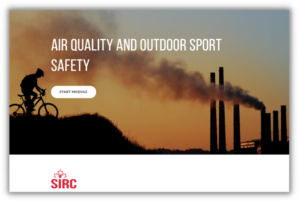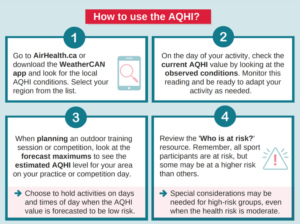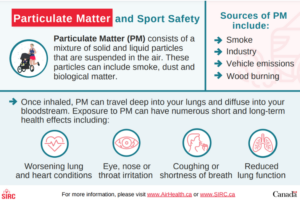Highlights
- In 2022, Health Canada and the Sport Information Resource Centre partnered to create educational resources to raise awareness about air quality and the safety of outdoor sport participation
- Air pollution can impact the health of all Canadians, but some groups, including people engaged in outdoor sport and exercise, are at an increased risk
- Monitoring air quality can help sport leaders determine if outdoor activity is safe or if it needs to be cancelled or rescheduled
- One tool that allows us to easily monitor air quality is the Air Quality Health Index (AQHI)
Most of us have been in a situation where we have arrived at an outdoor sporting event only to find that the game has been cancelled or rescheduled due to lightning. But have you ever had the same thing happen because of air pollution? While there is a broad understanding of how to protect sport participants from environmental events like lightning, few people know what to do when the air quality is poor.
To fill this gap, the Sport Information Resource Centre (SIRC) and Health Canada partnered to create and share air quality resources, including an e-learning module, infographics and a policy guide, for outdoor sport stakeholders. In this SIRCuit article, we describe the partnership between SIRC and Health Canada, highlight key information about air pollution and the safety of outdoor sport participation, and outline strategies that sport stakeholders can implement to help protect sport participants from the harmful effects of air pollution.
Throughout the article, we have linked to resources to help you spread awareness and take action in your sport. Together we can clear the air around air quality and the safety of outdoor sport participation!
The partnership
In 2022, Health Canada engaged SIRC to support its initiatives focused on air quality and outdoor sport safety. Health Canada provided SIRC with financial and scientific support for the creation of educational resources and tools for sport organizations, including:
 A free eLearning module, developed in conjunction with the Coaching Association of Canada, designed to help coaches, sport officials and sport leaders recognize the impact of poor air quality, and use the Air Quality Health Index (AQHI)
A free eLearning module, developed in conjunction with the Coaching Association of Canada, designed to help coaches, sport officials and sport leaders recognize the impact of poor air quality, and use the Air Quality Health Index (AQHI)- Infographics and info cards sharing information about key air pollutants and the AQHI in a format that is easy to share and revisit
- A policy template and guiding document designed to provide sport organizations with the information and tools needed to take proactive measures to prevent and limit outdoor sport participants’ exposure to air pollution
Health Canada and SIRC launched the eLearning module and supporting resources at the Ontario Soccer Summit in Ottawa, Ontario, on February 25, 2023. We will continue to share the resources developed through this partnership via an education and awareness campaign targeting organizations at all levels of sport.
The basics of air pollution
Air pollution is a mixture of chemical, physical and biological agents that contaminate indoor and outdoor environments (WHO, 2022). There are many different types of air pollutants. Some of the most harmful air pollutants to human health include:
- Ground-level ozone: a colourless and highly irritating gas
- Ground-level Ozone has been linked with the aggravation of respiratory illnesses, increased hospital visits and premature death (GoC, 2022b)
- Nitrogen dioxide: a gas that is emitted from many sources including gas stoves, fireplaces, and cars (GoC, 2021a)
- Nitrogen Dioxide can affect respiratory health, causing airway inflammation, reduced lung function and asthma aggravation (GoC, 2021a)
 Particulate matter: airborne particles, such as dust and liquid droplets (Anderson et coll., 2012)
Particulate matter: airborne particles, such as dust and liquid droplets (Anderson et coll., 2012)
- Particulate Matter can have many short and long-term health effects, including an increased risk of cancer and heart disease (Anderson et coll., 2012)
Air pollutants can come from many sources. In Canada, the highest emissions of air pollutants have been linked to electricity generation, construction, oil and gas industries, forest fires, transportation, agriculture and wood burning (GoC, 2022a). Environmental events can also contribute to poor air quality. Examples of environmental events that can contribute to air pollution include:
- Wildfires: an uncontrolled fire that burns in wildland vegetation, which are common in Western Canada between the months of April to October.
- Wildfires can negatively impact air quality because their smoke contains air pollutants such as particulate matter (Black et coll., 2017)
- Wildfire smoke can disperse over great distances, so even if sport participants are kilometres away from a wildfire, they may be affected by the smoke (Black et coll., 2017)
- The health effects from wildfire smoke can include a range of symptoms, including headaches and scratchy throats (Black et coll., 2017; GoC, 2021b)

- Smog: a mixture of air pollutants that we often see as haze
- Smog is made up of a mixture of gases and particles, including Nitrogen Dioxide and Particulate Matter (GoC, 2014)
- High smog levels are often associated with warmer summer months, but smog can occur year-round (GoC, 2014)
- For example, in the winter, smog can occur from increased wood burning and vehicle emissions (GoC, 2014)
- Exposure to smog has been associated with increased hospital and doctor visits as well as premature deaths (GoC, 2014)

- Temperature inversions: occur when a layer of cold air gets trapped below warm air, which is common in areas with low elevation, like in valleys (EEA, 2020)
- The warm air acts as a lid, keeping the cold air and pollutants close to the ground resulting in high concentrations of air pollutants at ground level (EEA, 2020)
The effects of air pollution on human health
Exposure to air pollution can lead to a range of short and long-term health effects. While short-term exposure to air pollutants has been linked to symptoms such as dizziness and headaches, long-term exposure has been associated with an increased risk of illnesses such as lung cancer and asthma (HC, 2021). In fact, in Canada, it is estimated that air pollution contributes to 2.7 million asthma symptom days and 15,300 premature deaths each year (HC, 2021).
It is important to note that while the long-term health effects of air pollution can take years to develop, the short-term health effects can occur within minutes of exercising in an environment where the air quality is very poor. This highlights the importance of monitoring air quality when planning or engaging in physical activity.
You may be wondering: who is at risk of experiencing the adverse effects of air pollution? The answer is that everyone is at risk. However, some groups, including, children, older adults and individuals with pre-existing medical conditions are at an increased risk. Although you might not suspect it, people engaging in sports and exercise are at increased risk too.
The effects of air pollution on outdoor sport participants
Why are athletes at an increased risk? When a person engages in physical activity outdoors, they require more oxygen (Carlisle et Sharp, 2001; Giles et Koehle, 2014). The harder they exercise, the more oxygen their body needs. To meet this increased need, a person must breathe more deeply and more frequently (Carlisle et Sharp, 2001; Giles et Koehle, 2014; EPA, 2011). If the air quality is poor, this increased air intake during exercise means that a person will also breathe in more air pollutants.
Another reason why outdoor sport participants are at increased risk is because when a person exercises heavily, they breathe more through their mouth than their nose (Carlisle et Sharp, 2001; Giles et Koehle, 2014). This means that that less air is filtered through the body’s natural filtration system in the nose, which means more air pollutants have the potential to enter the body (Bateson et Schwartz, 2007).
To summarize, athletes shift their breathing pattern and style during exercise to inhale greater amounts of air. If they are in an area with high air pollution levels, for example, near a busy roadway, they inhale more air pollutants, putting them at an increased risk of health complications.
Poor air quality can also affect athletic performance. When athletes exercise in areas with high air pollution levels, they tend to have a higher perceived exertion (Sandford et coll., 2020). More simply, exercising when the air quality is poor can make outdoor sport participants feel like they are working harder to do the same task. This can mean that athletes can’t perform at the same level as they do when the air quality is good. As you can imagine, this can have considerable implications in outdoor sporting events requiring endurance, like soccer, or timed events, like those in track and field.
The Air Quality Health Index
At this point, you may be wondering what you can do to help protect sport participants from air pollution. The answer is that you can monitor local air quality and make informed decisions about the safety of outdoor sport participation. To do that, you can use the (AQHI).
The AQHI was created to help individuals understand and make decisions about the safety of the air around them. The AQHI presents the relative health risk associated with the combined health effects of air pollutants, including Nitrogen Dioxide, Ground-level Ozone and Particulate Matter. The AQHI is presented on a scale of 1 to 10+, which is further broken down into four health risk categories ranging from low risk (1 to 3) to very high risk (10+).

The AQHI shows observed and forecasted values, so you can use it to measure air quality before and during your event. The AQHI values are accompanied by health messages. These messages can be used to support your decisions around the safety of outdoor sport participation. When reading the health messages, it is essential to remember that outdoor sport participants are considered a high-risk population. As such, more conservative approaches should be taken to ensure their safety.

Below are some general guidelines on how the AQHI can be used for planning outdoor activity. As a coach, sport official or leader it is up to you to assess the needs of your participants as well as your environmental conditions to determine if outdoor sport participation is safe.
- When the health risk is low (AQHI 1 to 3), it is the optimum time to schedule and participate in outdoor sport and physical activities
- When the health risk is moderate (AQHI 4 to 6), outdoor activities may still be held
- However, particular attention should be given to participants with pre-existing medical conditions such as asthma
- When the health risk is high (AQHI 7 or above), outdoor events should be cancelled, re-scheduled, or moved to an indoor location whenever possible
To access the AQHI visit AirHealth.ca or download the WeatherCAN app on Google Play or in the App Store.
Strategies to limit sport participants’ exposure to air pollution
Sport organizations, coaches and officials are responsible for the safety of their participants. Here are a few things you can do stay informed and limit sport participants’ exposure to air pollution:
- Monitor the news and trusted social media sources for local and regional public health air quality alerts, or better yet, check the AQHI values for your region!
- Cancel or reschedule outdoor sport activities on days when air quality is poor
- Choose locations for outdoor sport activities away from sources of air pollution, such as factories or heavily used roadways
- Plan outdoor activities for when traffic levels are at their lowest, especially if your practice location is near a busy roadway
- Relocate outdoor sport activities to indoor venues when air quality is poor
- Educate your participants about air quality and the dangers of exercising outdoors when the air quality is poor
- Create and implement an air quality policy so that everyone in your organization knows how to safely engage in outdoor sports
Final thoughts
We hope that this article helps get you thinking about air quality and the safety of outdoor sport participation. We encourage you to use this information to start discussions within your organization or teams about the importance of considering air quality when planning and participating in outdoor sports. Remember that when air quality is poor, it is essential to modify outdoor activities to protect the health of outdoor sport and physical activity participants, as poor air quality can impact health.
An important next step for sport organizations is to develop air quality policies that support safe outdoor sport participation. The policies should provide guidance on appropriate actions to take during poor air quality events and establish education and training expectations on AQHI for coaches and sport officials. If you have any questions or need any supports as you begin this process, please do not hesitate to reach out to the SIRC team at info@sirc.ca.
Resources to explore for further learning
Below are some resources that you may find helpful as you work to learn more about air pollution and what your organization can do to help keep your participants safe:
 Particulate matter: airborne particles, such as dust and liquid droplets (Anderson et coll., 2012)
Particulate matter: airborne particles, such as dust and liquid droplets (Anderson et coll., 2012)